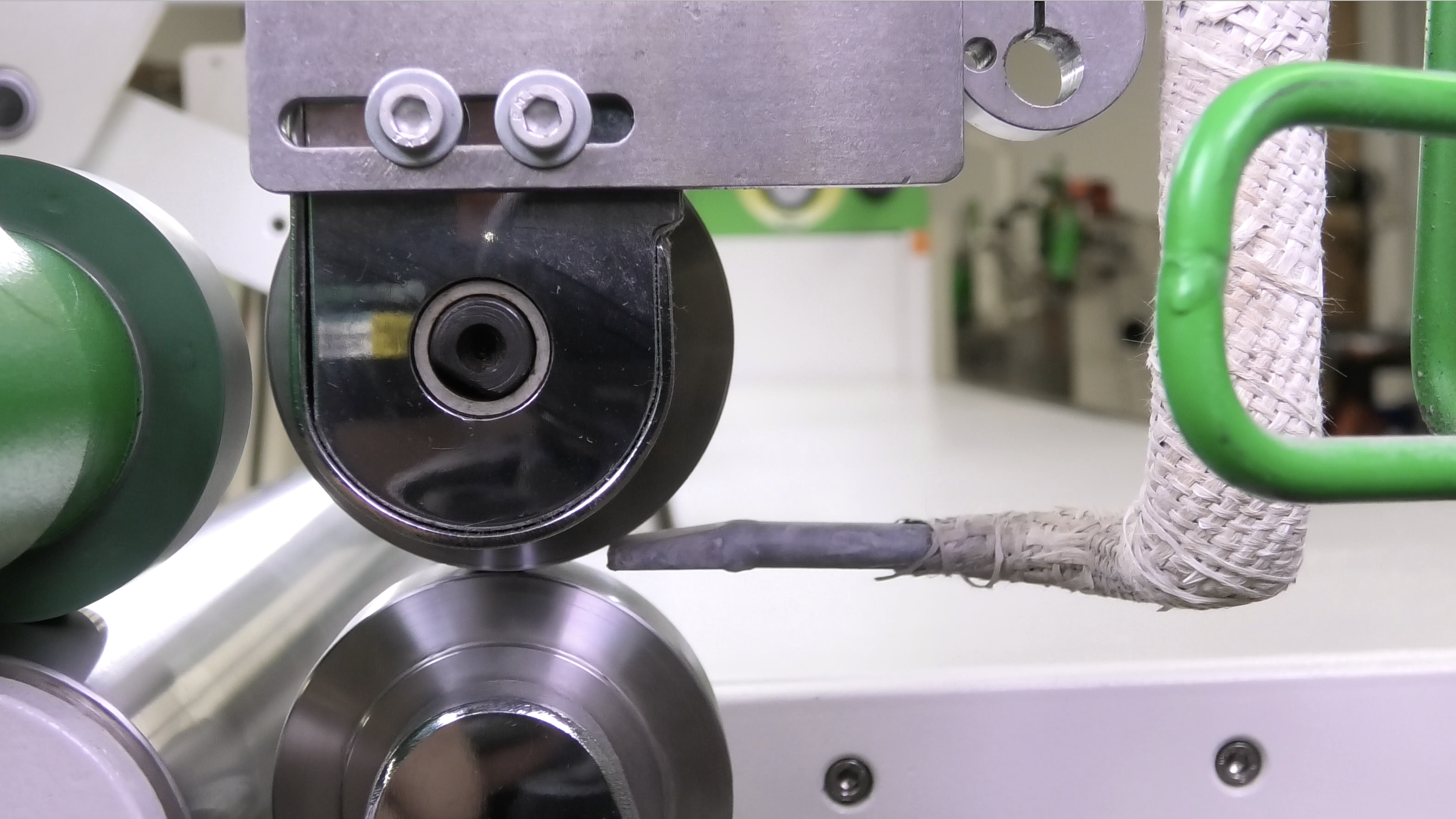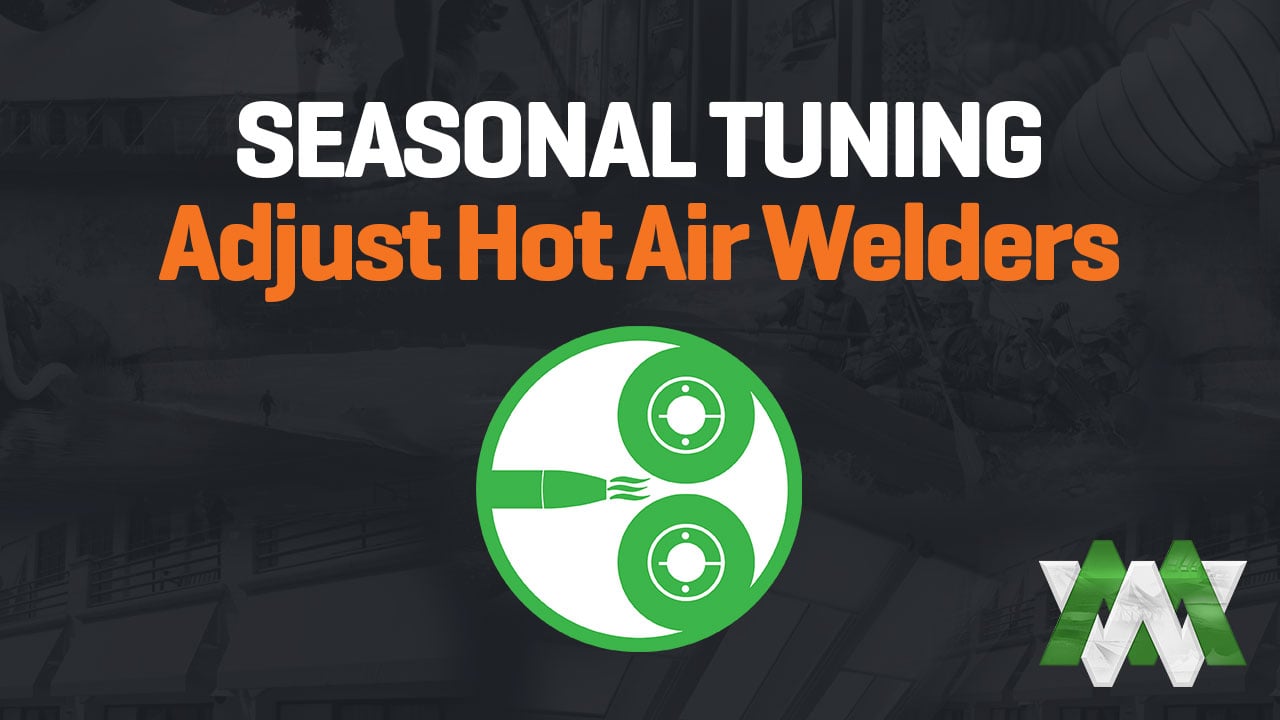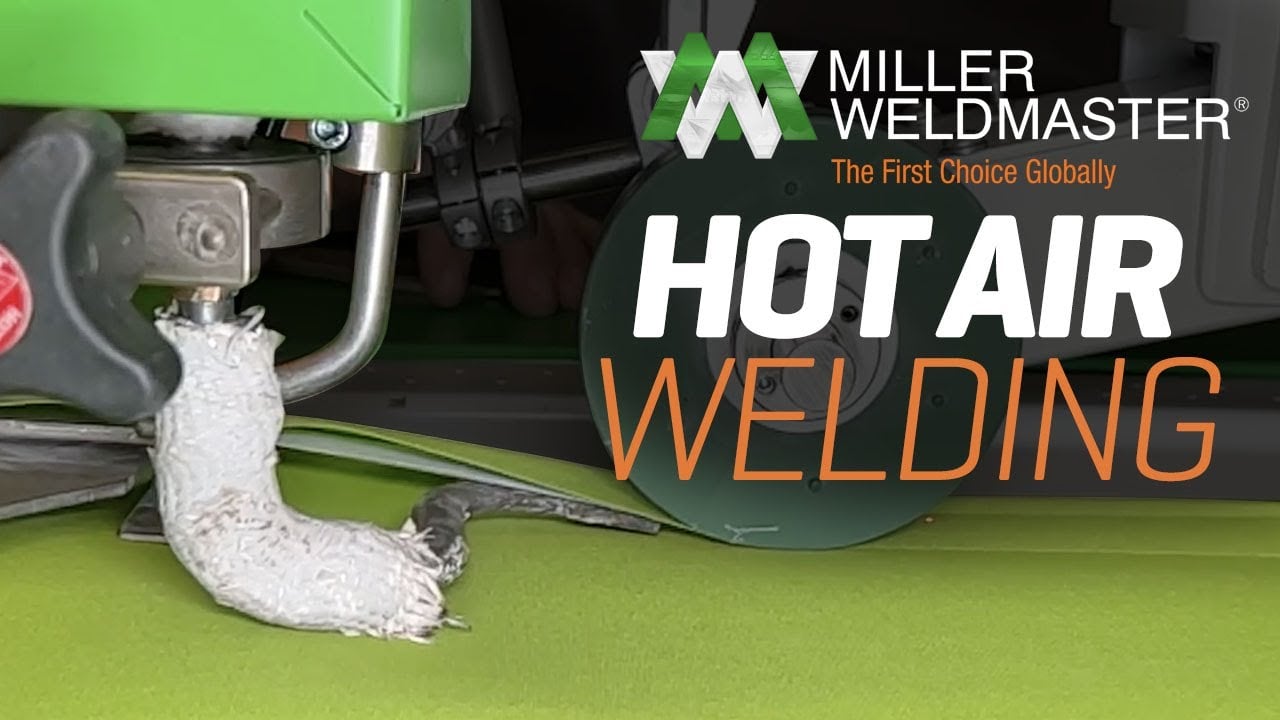Hot air welding machines have revolutionized the way industrial fabrics are joined, providing strong, clean, and reliable seams without the need for adhesives or stitching. Whether you manufacture tarps, banners, or inflatables membranes, understanding how hot air welding works and how to choose the right machine can dramatically improve your production quality and efficiency. This guide will break down everything from the basic hot air welding process to the latest industrial fabric welding techniques.
If you're exploring options for fabric sealing and looking for a full overview, you're in the right place. For a technical breakdown of how hot air welding works, check out our hot air welding technology page.
What Is a Hot Air Welding Machine?
A hot air welding machine is a specialized tool designed to fuse thermoplastic materials using a precise combination of heat, pressure, and motion. It works by directing a stream of hot air between two overlapping pieces of fabric, softening the material at the seam. As heated rollers press the materials together, the molten surfaces bond and form a durable, continuous weld.
Unlike other methods, hot air welding is a non-contact process. The heat is applied via a nozzle rather than a direct element, reducing material stress and distortion. This makes it ideal for a range of applications. In contrast, methods like MIG welding involve direct contact with the base metal, which can lead to more stress and potential distortion of the material.
Understanding the science behind these machines ensures precise, reliable results across industries. It also positions you to make more informed decisions as you select equipment and refine processes.
How Hot Air Welding Works
The hot air welding process can be broken into a few essential steps:
-
Material Feeding: Two pieces of thermoplastic fabric are overlapped in preparation for welding.
-
Heat Application: A nozzle directs heated air (typically between 300°C to 800°C) into the overlap area.
-
Pressure Application: Heated rollers press the softened materials together, bonding them. This process creates a durable bond that prevents issues like tearing or leaking.
-
Movement Control: A motor or operator moves the machine steadily along the seam.
Each variable—temperature, pressure, and speed—must be carefully calibrated to suit the fabric type and thickness. A well-executed weld will have no gaps, burns, or bubbles.
Benefits of Using Hot Air Welding Machines
Hot air welding offers a wide array of advantages for fabricators and industrial operations:
-
Strong, Durable Seams: Welds are often stronger than the base material.
-
Speed & Efficiency: High-speed production with less downtime.
-
Non-Contact Process: Reduces fabric stress and avoids direct flame or friction.
-
Automation Ready: Easily integrates into automated lines by adding unwinds, rewinds or more.
-
Versatile: Suitable for diverse materials and seam configurations.
-
Cost-Effective: Less waste, no consumables like glue or thread.
Using the right technique is crucial for achieving strong, durable seams, as each welding method requires a specific approach tailored to the material being used.
Hot Air Welding vs. Other Methods
Here’s how hot air welding compares to other common industrial fabric joining methods:
-
Hot Wedge Welding: Uses a heated metal wedge instead of air; better for thick or rigid materials.
-
RF Welding: Uses radio-frequency energy; best for materials with high dielectric properties (e.g. PVC). Radio frequency welding joins thermoplastic materials through high-frequency electromagnetic waves, making it an efficient and precise alternative to other welding techniques.
-
Ultrasonic Welding: Uses high-frequency vibrations; limited to specific materials and thin fabrics.
-
Solvent or Adhesive Bonding: Relies on chemicals; slower and less eco-friendly.
Hot air welding is especially beneficial for large surface seams, mobile field operations, and applications needing minimal material distortion.
Components of a Hot Air Welding Machine
A well-designed hot air welder is a synergy of precision parts:
-
Heater: Manages temperature output through adjustable settings.
-
Nozzle: Directs hot air precisely between material layers.
-
Pressure Rollers: Bond the softened fabrics by applying consistent force.
-
Motor: Drives movement for uniform seams.
-
Control Interface: Lets operators program settings like temperature, speed, and air volume.
Each part plays a crucial role in producing high-quality, repeatable welds.
The Role of Automation in Hot Air Welding
Modern hot air welding machines often include automation features like:
-
Programmable Settings: Save and recall welding parameters.
-
Sensors: Monitor temperature and seam alignment.
-
Digital Interfaces: Touchscreens or remote software for easier control.
-
Material Guides: Ensure straight, consistent seams.
These technologies help reduce training time, minimize human error, and improve consistency, especially in high-volume operations.
Applications of Hot Air Welding in Industrial Fabrication
Hot air welding is used across a wide range of industries and products, including:
-
Tarpaulins and Truck Covers
-
Tents, Awnings, and Shelters
-
Inflatable Structures
-
Vinyl Banners and Billboards
-
Roofing Membranes and Geosynthetics
-
Curtains, Conveyor Belts, and Industrial Dividers
Explore more applications for tarps and tarpaulins here.
Why Hot Air Welding Is Ideal for Thermoplastic Fabrics
Hot air welding works best with thermoplastics, including:
-
PVC (Polyvinyl Chloride)
-
PE (Polyethylene)
-
PU (Polyurethane) coated fabrics
-
PP (Polypropylene)
These materials soften when heated and harden upon cooling, creating a molecular bond during the welding process. To ensure long-term durability, testing for seam strength, peel resistance, and water resistance is recommended.
How to Choose the Right Hot Air Welding Machine
Selecting the right hot air welding equipment is crucial for quality and efficiency. Use this checklist:
-
Fabric Type: What thermoplastic material are you welding?
- We are primarily welding thermoplastic materials such as polyethylene (PE), polypropylene (PP), and PVC-coated woven fabrics, commonly used in packaging and industrial applications like step-cut bottom bags and tarpaulins.
-
Seam Width: Do you need narrow or wide welds?
- We require wide welds, especially for applications like bag side seams, tarpaulin panels, and roofing membranes. A consistent, reinforced seam is critical for durability and product integrity.
-
Production Volume: Is your operation high-speed or custom/small batch?
- Our operation includes both high-speed production lines and some small batch/custom runs. We need flexibility to handle large daily volumes efficiently while also adapting to shorter custom orders when needed.
-
Portability: Do you need a portable hot air welder or a stationary unit?
- We use both stationary hot air welders for our production floor and portable hot air welders for occasional on-site repairs or demonstrations at trade shows. Our Elite Air is a versatile handheld welding tool for in-house or in-the-field instant repairs of industrial fabrics. With accelerated warm up times to get you started almost immediately and a light weight, balanced design, the Elite Air will deliver solid performance all day long. Portability is helpful for flexibility but not a core requirement.
-
Skill Level: Is the machine operator new or experienced?
- Our machine operators range from moderately experienced to advanced. While we do train new staff regularly, we generally prefer machines that are intuitive but also allow for deeper parameter control for our experienced operators.
Also consider the service, training, and ongoing support available—areas where Weldmaster’s T300 machines excel.
When Is Hot Air Welding the Right Choice?
Choose hot air welding when:
-
You need fast, repeatable seam production.
-
This means you're running a manufacturing operation where speed and consistency are critical. Whether you’re sealing hundreds of bags a day or producing long seams for large products like tents, truck tarps, or roofing membranes, you need:
-
A process that maintains uniform quality across every seam.
-
Automation or semi-automation to minimize operator fatigue and human error.
-
Minimal downtime for setup or switching between welds.
Hot air welding is ideal here because it can be calibrated for repeat settings and run in continuous cycles—perfect for high-throughput production environments.
-
-
-
Stitching isn’t durable or waterproof enough.
-
In some industries, stitching simply doesn’t cut it. This is especially true when:
-
The product must be completely waterproof (e.g., inflatable rafts, roofing membranes, containment liners).
-
Exposure to UV, chemicals, or weather can degrade thread over time.
-
Seams need to be airtight or pressure-resistant, like in inflatables or industrial curtains.
Hot air welding creates a molecular bond between thermoplastic materials, resulting in a seam that's often stronger than the material itself—far outperforming traditional sewing or adhesive methods in terms of longevity and performance.
-
-
-
Flexibility is required (e.g., mobile field repairs).
-
Sometimes the job isn’t done in a factory. You might be:
-
Repairing a tarp on-site at a logistics hub or construction site.
-
Sealing banners or roofing materials during an installation.
-
Performing quick fixes at events or emergency shelters.
In these cases, a portable hot air welder is a game-changer. You can take the machine to the job, plug it in, and complete professional-grade welds without needing a full production setup. This level of mobility is essential in field service, outdoor installation, or anywhere on-the-go welding is required.
-
-
-
You're working with medium to large-scale thermoplastic assemblies.
-
This refers to the size and scope of the materials you're welding. If you're manufacturing or assembling:
-
Truck tarps or curtain sides
-
Large advertising banners
-
Pool liners or geomembranes
-
Tent structures or shelters
You’re likely handling wide, long pieces of thermoplastic-coated fabric. These require long seams, often multiple meters in length, that must be welded efficiently and with perfect alignment.
Hot air welding machines are built to handle these dimensions with features like:
-
Material guides and rollers for smooth feeding.
-
Wide nozzles and rollers to accommodate large seam widths.
-
Programmable automation for long, uninterrupted welds.
-
-
It’s not the only welding method, but it's one of the most versatile and scalable for industrial fabrics.
Why Expertise Matters in Hot Air Welding Technology
While hot air welding machines are powerful tools, their success depends heavily on how well they’re operated and maintained. Partnering with experts who understand thermoplastics, machine calibration, and industrial requirements can help you:
-
Achieve better seam consistency.
-
When you partner with a knowledgeable hot air welding equipment provider or industry expert, you're tapping into years of research, application testing, and real-world experience. Here's how that translates to consistent seams:
-
Precision Calibration: Experts help dial in the exact temperature, pressure, and speed settings for your specific material—ensuring every seam is strong, uniform, and visually clean.
-
Custom Tooling & Nozzles: For specialty applications, having access to tailored components (like custom nozzles or rollers) can significantly improve seam accuracy.
-
Process Optimization: They’ll guide you on fabric handling, overlap positioning, and proper feeding techniques to prevent weak spots, bubbles, or missed welds.
The result? Repeatable, high-quality seams with minimal rework and a reduced chance of product failure in the field.
-
-
-
Minimize machine downtime.
-
Downtime is expensive—whether it’s due to improper settings, worn components, or operator mistakes. Experts help reduce it by:
-
Preventive Maintenance Guidance: You’ll know when and how to replace parts like heating elements or rollers before they fail.
-
Diagnostics & Support: Reliable providers offer fast troubleshooting, remote diagnostics, or even on-site service to get you back up and running quickly.
-
Training on Error Avoidance: By understanding what typically causes machine faults or poor welds, your team can prevent issues before they occur.
That means more uptime, less interruption to your workflow, and improved overall equipment effectiveness (OEE).
-
-
-
Improve operator training.
-
Even the best hot air welder is only as good as the person operating it. Industry experts help shorten the learning curve and boost performance through:
-
Hands-on Onboarding: They walk your team through real-life use cases, showing how to set up and run welds correctly.
-
Process Documentation: You’ll receive step-by-step guides or video tutorials tailored to your machine and materials.
-
Ongoing Education: Many offer refresher training or updates when new machine features or materials are introduced.
The outcome is fewer mistakes, more confidence on the floor, and a safer, more productive welding environment.
-
-
-
Optimize ROI over the long run.
-
Hot air welding machines can be a significant investment—but the right partner ensures you get maximum return over time by:
-
Helping you select the right machine for your operation—neither over- nor under-buying.
-
Reducing material waste and rework, thanks to stronger, more accurate welds.
-
Improving throughput, which means faster time-to-market and increased production capacity.
-
Extending machine lifespan through proper maintenance and updates.
By improving performance across the board—from training to machine utilization—you’re not just buying equipment; you’re investing in a more profitable, scalable operation.
-
-
Experienced providers will also support you through machine selection, installation, and troubleshooting.
Getting Started With Hot Air Welding: What to Know Before You Begin
Before diving into the hot air seaming process, here are a few key tips:
-
Define your specific application and fabric type.
-
Research available machine models and configurations.
-
Evaluate operator training and support resources.
-
Plan for future scalability.
Whether you’re new to industrial fabric welding or looking to improve your current setup, informed decisions start with understanding the process.
Hot air welding machines are a cornerstone of industrial fabric fabrication, offering reliability, strength, and efficiency. From tarpaulins to tents and inflatables, their applications span across industries and innovation continues to push the boundaries of what these systems can do. When you're ready to invest in a hot air welder, take the time to evaluate your needs and choose a knowledgeable partner to support you every step of the way.
Explore more about our T300 Flex or speak to a specialist to learn which model is right for your operation.
Frequently Asked Questions About Hot Air Welding Machines
What materials can be welded using hot air welding machines?
PVC, PE, PP, and PU-coated fabrics are the most common thermoplastics compatible with hot air welding.
Is hot air welding suitable for outdoor applications?
Yes. The process produces durable, waterproof seams ideal for tarps, banners, and roofing membranes.
How strong are hot air welded seams compared to sewing or gluing?
Properly welded seams often exceed the strength of sewn or glued seams and are airtight and watertight.
Can I weld different types of thermoplastic fabrics together?
It depends. Fabrics must have similar melting points and compatible surface chemistries for effective bonding.
What safety precautions should I take when using a hot air welder?
Use heat-resistant gloves, eye protection, and ensure proper ventilation when welding indoors.
What’s the difference between automatic and handheld hot air welders?
Automatic welders are ideal for high-volume, consistent seams. Handheld welders offer mobility and flexibility for repairs or small jobs.
How do I maintain a hot air welding machine?
Regular maintenance includes cleaning the nozzle, checking roller alignment, and calibrating temperature sensors.
What is the typical lifespan of a hot air welded seam?
With proper material and weld settings, seams can last as long as the base fabric—often many years under normal use.
Do I need training to operate a hot air welder?
Yes. While some machines are user-friendly, training ensures safe operation and optimal seam quality.
When is hot air welding not the best option?
For very thick materials, dissimilar plastics, or applications requiring extreme precision, other welding technologies like RF or ultrasonic may be better suited.




